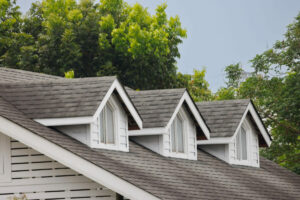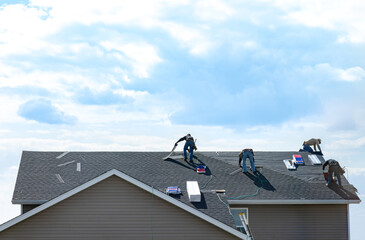Your roof protects your home from severe storms, high winds, and other elements. It can also add beauty, style, and energy efficiency to your home.
Roofer Round Rock structure is a frame of beams, trusses, and rafters that the sheathing is laid on top of. It helps keep the sheathing from water damage and supports the other roofing materials.

Shingles are flat, rectangular pieces of wood or other roofing material organized in overlapping rows to cover the roof surface. However, there’s much more to a shingle (and a shingle roof) than that.
Shingle roofs are often made of fiberglass-based asphalt shingles. This material is the most common residential roofing choice because it’s easy to install, affordable, and lasts about 20 years or more. But shingle options are also made of clay tile, slate, and other materials.
The shingle base can be made of paper, fiberglass, or other materials. It provides structural support and helps to hold the asphalt shingle together. In addition, the shingle base can help protect the structure from moisture penetration.
Most shingles are designed with various colors and styles to suit many different types of homes. Even “designer” shingles offer high-end aesthetics and enhanced performance characteristics like impact resistance.
One of the most recognizable types of shingles is the three-tab shingle, which gets its name from the cutouts that resemble three individual tabs. This type of shingle is the least expensive option for an asphalt roof and usually comes with limited warranties for 25-30 years.
Other popular shingle options include architectural or laminate shingles, which are thicker and more durable than standard three-tab. They can also be designed to resemble shakes or slate, which creates a more dimensional look for the roof. These premium shingles may come with slightly higher price tags than the regular grade.
There are also specialty shingles available for the hips and ridges of a roof. These shingles are made to contour to the shape of these areas, which can be difficult to cover with a regular shingle. Additionally, there are shingle options designed to be solar-reflective or thermal-emissive. These shingles can help reduce the amount of energy a home uses.
Most shingle roofs require little maintenance outside routine inspections and addressing special issues like moss or lichen. However, if your shingle roof becomes damaged or worn, you can always contact a roofing professional to replace it.
A roof is an essential part of a structure that protects the interior and the people inside from rain, snow, sunlight, and wind. It is made of shingles, tiles, or metal and can cover an existing building or be built on top of a new one. The word roof also refers to the covering covering the frame and underlying parts of the structure.
There are many types of roofs, and the structure of a roof may vary depending on the style and design of the building. The roof frame is known as the roof framing and acts as the foundation on which the other components are built. It consists of a series of joists and beams that form the shape of the roof. It is a vital part of a house, and the proper roof construction must be done to avoid structural problems.
The most common type of roof is the gable roof, which has two sloped sides that meet at the top to form a triangular wall. It is one of the most popular roofing styles and is easy to construct. It is also very stable and can withstand high winds. A gable roof can also have a ridge vent, an air exhaust placed at the highest point of the roof to help prevent hot air from trapping in your home.
Another type of roof is a hip roof with multiple sloped sides that meet at a single peak. These roofs are very strong and do well in areas that experience a lot of rainfall. These roofs can have a roof plumbing vent, which is a vent that helps to alleviate pressure from the pipes in your house.
A soffit is the underside of a roof that is installed behind the eaves of the building. It helps to keep the rain and insects from getting in through the eaves. This is a very important part of a roof, often constructed from the same material as the eaves and fascia.
The roof of a house is the outermost part of the building, which protects against extreme weather conditions such as scorching heat, torrential rain, or snowfall. A man’s most fundamental requirement is shelter, which he seeks as a roof. Even the poorest people desire a roof over their heads, though they may not have walls or floors. The roof is the first thing one notices about a house when driving by or visiting it.
Roofs come in various shapes and sizes, with shingles being houses’ most common roofing material. A shingle is usually made of fiberglass and asphalt, which protects the roof from the rain while lending its character. They also come in nearly limitless colors and can be designed at different angles to create unique architectural features.
Different roof materials depend on the climate in the building’s region. Concrete tiles, for instance, are made of a combination of cement, water, and sand baked in high temperatures, giving them their color and making them resistant to weathering. On the other hand, a slate roof is a very durable and sturdy type of roof that lasts 100 years or more. It requires special maintenance and can be expensive to install, but its durability makes it worth the investment.
While the primary function of a roof is to shield occupants and their belongings from harsh weather elements, it is also a vital structural component of a home. It evenly distributes the weight of the structure’s load (that is, its dead weight plus the additional load from the structural roof covering and extra loading) across the supporting frame to prevent sagging or collapse.
A well-designed roof will also provide sound insulation, which is important for a comfortable living environment. It will also help to regulate the temperature inside the building, depending on the type of materials used in its construction and the method by which it is installed. Choosing a fire-resistant material is also a good idea, especially in areas where wildfires or other natural disasters may occur.
Roofing felt is a layer of tar paper that lines the roof before shingles or other roofing materials go on top. Also called roofing, underlayment is an extra layer of protection that prevents moisture from seeping into the house. It is especially effective for homeowners who use asphalt shingles, which are less durable than other roofing materials and more prone to leaks.
Felt can be made from various types of material, with fiberglass fleece being the most long-lasting and tearing-resistant. The fabric is then dipped or otherwise saturated with a tar-like substance known as asphalt (bitumen) to give it its waterproof qualities. Other underlayment forms include rubberized asphalt sheets, which are more modern and have greater water resistance than traditional felt.
The type of roofing felt that you need for your home will depend on the type of shingle you have chosen and your climate. For example, a felt underlayment can prevent shingle blow-off and moisture penetration in areas with high winds. This is because it shores up the underlying structure of the roof and acts as a barrier against wind-driven rain and snow.
Aside from preventing moisture from penetrating the house, roofing felt can also help to protect against wood resin stains. This is because the underlayment shields the shingles from the resin emitted by the wood as it expands and contracts during weather changes. Lastly, it can help protect roofers working on steep pitches by presenting a layer of protection that is easier to walk on.
While the benefits of roofing are obvious, technology is continually improving in this area. For example, some newer shingle underlayments feature a slip-resistant coating that makes it safer for roofers to work on. Moreover, there is now synthetic underlayment that is lighter and more resistant to punctures than felt, as well as better at allowing air to pass through the roof space, which can help to reduce condensation and dampness in the home. All in all, no matter what kind of roof you have, pairing it with roofing felt is always a good idea for an added layer of protection.


